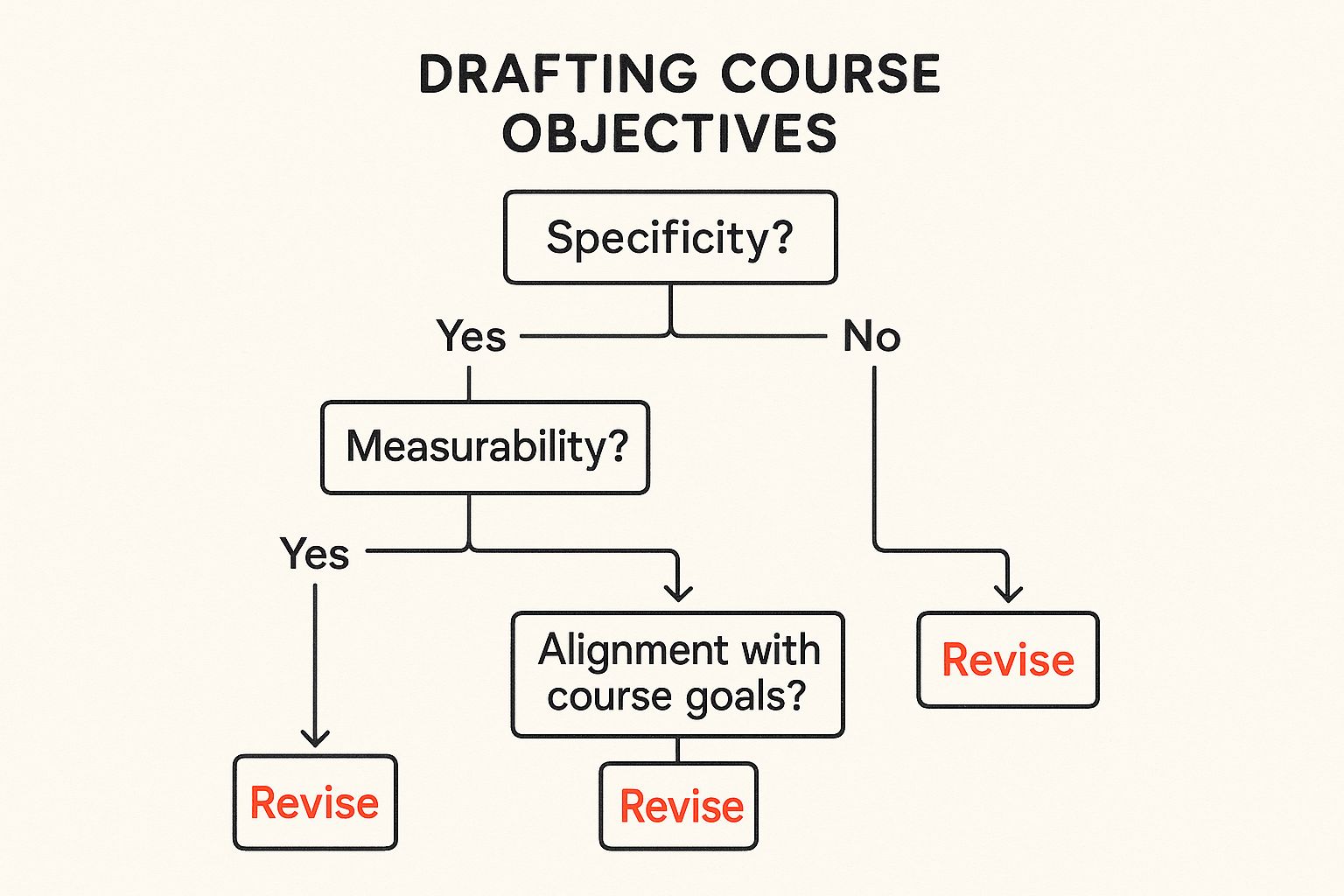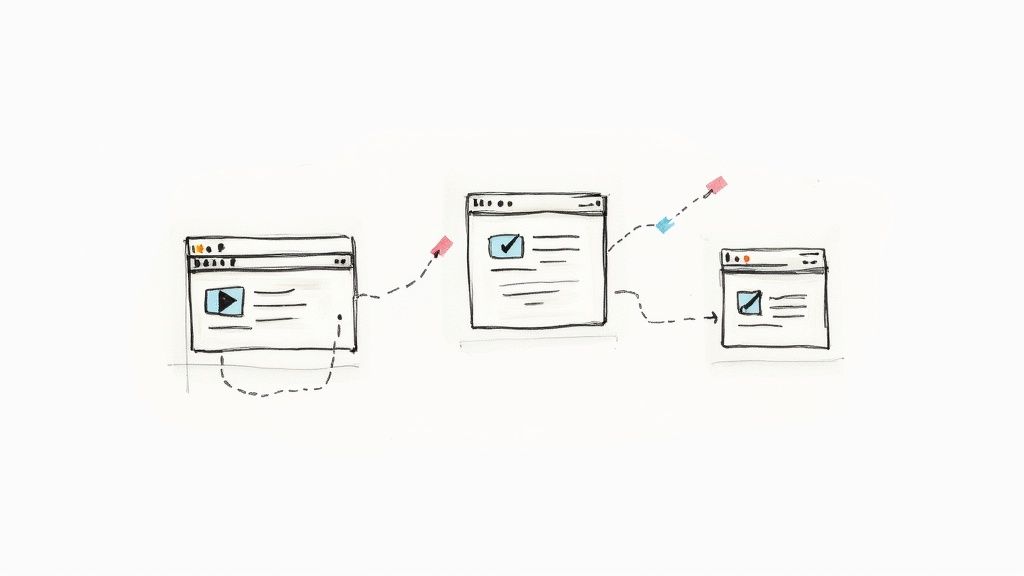When we talk about instructional design for online courses, we're really talking about the art and science of building a great learning experience. It’s not just about dumping a bunch of information online and calling it a day. It's a deliberate process that blends learning theory with modern technology, crafting a journey that is effective, engaging, and accessible. The goal is to ensure students don’t just see the material, but actually learn from it.
A thoughtful approach means your course isn't just informative—it's genuinely impactful.

Let’s be honest, the days of downloading a massive PDF or sitting through a dry, hour-long video lecture are over. Or at least, they should be.
Today's learners are used to the slick, intuitive experiences they get from apps and websites every day. Their expectations are high. They want learning that is interactive, flexible, and respects their time. Anything less just feels clunky and outdated. This is why the latest trends in instructional design, like AI-driven personalization and Microlearning, are no longer niche concepts but core components of effective course creation.
This is exactly why instructional design has moved from a "nice-to-have" to a must-have. It’s the single biggest factor that determines whether an online course actually works. A well-designed course doesn't just throw facts at you; it guides you on a structured path that builds your knowledge piece by piece and keeps you hooked.
The impact of getting this right is huge, and you can see it in the numbers. When learners are actually engaged, they're far more likely to finish the course and, crucially, remember what they learned. This has a direct effect on results, whether you're trying to upskill your team, certify professionals, or teach someone a new hobby.
This demand for quality is fueling massive growth. The global online education market is expected to hit a staggering £150.35 billion by 2025. A huge slice of that value comes from courses that are genuinely well-crafted. In fact, solid instructional design can push course retention rates up to 60%, which blows the typical 8–10% of traditional classrooms out of the water. If you're curious, you can dive deeper into the latest online learning statistics to see the full picture.
Great instructional design is invisible. Learners don't notice the intricate framework, the carefully selected activities, or the psychological principles at play. They just know the course works, feels intuitive, and helps them achieve their goals.
So, what does this actually look like in practice? It means ditching the "content dump" mentality and putting the learner at the center of everything. Think of an instructional designer as an architect for the learning experience.
Here’s what that involves:
Ultimately, strong instructional design ensures you’re not just creating content—you’re creating change. It’s about building a solid bridge between your information and someone's genuine understanding. In today's world, that skill is more vital than ever.
Before you can build anything great, you need a solid blueprint. In the world of online course creation, that blueprint comes from proven instructional design models. These aren't just stuffy academic theories; they're practical roadmaps that bring order to your creative chaos and make sure you don't skip the important stuff.
It's so easy to get lost without a framework. I've seen it happen—people jump straight into recording videos without truly understanding who they're teaching. Or they'll build a gorgeous-looking quiz that doesn't actually test the skills that matter. A good design model is like a GPS, guiding you from that first spark of an idea to a finished course that actually works.
Two of the biggest names you'll hear thrown around are ADDIE and SAM. Just think of them as two different ways to build a house.
ADDIE is the classic, step-by-step method. It stands for Analysis, Design, Development, Implementation, and Evaluation. You finish one phase completely before moving to the next, which makes the whole process thorough and predictable. It's a great fit for big, complex projects where the requirements are crystal clear from day one and you need formal sign-offs at every stage.
Then there's SAM, the Successive Approximation Model. This one is way more agile and looping. You build small, testable pieces of your course, get feedback, and refine them in quick cycles. This approach is a lifesaver for projects where you need to be flexible and adapt on the fly. It's perfect for creating things like Microlearning modules or when you don't have the final picture perfectly defined from the start.
The best model is simply the one that fits the reality of your project. Don't try to shoehorn a fast-moving, uncertain project into a rigid, linear process. And don't use a rapid-cycle model when what you really need is detailed, upfront planning.
Let's make this real. Imagine you're designing an onboarding course for new users of a complicated software tool. The big goal is to get them comfortable with the core features within their first week.
For a project like this, I'd probably use a hybrid approach. We could borrow the Analysis phase from ADDIE to really dig into who our users are (what's their tech background? what are they trying to accomplish?) and clearly define what "proficient" actually looks like. But after that, we could switch to a more SAM-like process for the actual creation.
This blend gives you the rock-solid foundation of ADDIE's analysis with the speed and real-world feedback of SAM. To really lay a strong groundwork for your educational offerings, it’s worth consulting a definitive creator's guide on how to create and sell online courses.
Once you know your audience and your goals, you have to write clear learning objectives. Think of these as the promises you're making to your learners. Vague goals like "Understand the software" are completely useless. You need to focus on specific, measurable actions.
A good learning objective always answers the question: "What will the learner be able to do after this lesson?"
Here’s how to turn a fuzzy goal into a sharp objective:
See the difference? These strong objectives become your North Star. They tell you exactly what content to create, what activities to design, and what to test in your quizzes. It fundamentally shifts the focus from what you are teaching to what the learner is actually achieving.
If you want to go deeper on a structured framework, our article on the ADDIE model for training breaks it down beautifully. Getting this part right ensures your entire course is built on a foundation of purpose.
Let’s talk tech. Picking the right software isn't just about delivering your content—it's about shaping the entire learning experience. Your tech stack is the vehicle that gets your course from your brain to your audience. Today’s instructional design weaves theory directly with software, so making the right choice is critical.
It helps to think of it like this: are you building a guided tour bus or handing over the keys to a rental car? Both get people to the destination, but the journey is fundamentally different.
The first big decision is usually where your course will live. This is where the Learning Management System (LMS) and the Learning Experience Platform (LXP) come into play.
An LMS is your classic, top-down workhorse. It’s perfect for structured learning like compliance training, formal certifications, or academic programs where you need to guide learners down a specific path. It’s all about administration, tracking completions, and managing enrollments.
An LXP, on the other hand, feels more like a mashup of Netflix and a professional social network. It puts the learner in control, letting them discover content based on their own interests and career goals. It often uses AI to recommend resources from all over—internal courses, articles, videos, you name it. For a deeper dive, you can learn more about the different learning management system types and figure out what makes sense for you.
The question isn't "Which one is better?" but "Which one supports my learning goal?" An LMS is for directed learning; an LXP is for self-directed discovery. Honestly, many organizations use a blend of both to cover all their bases.
Once you know where the course will live, you need to actually build it. That's where authoring tools come in. These are the specialized apps you use to create everything from simple presentations to complex, interactive simulations.
Two giants pretty much own this space: the Articulate Suite (specifically Storyline 360 and Rise 360) and Adobe Captivate. The right choice really depends on what you're trying to build and how tech-savvy your team is.
I get asked about Articulate vs. Adobe all the time. Here’s a practical, no-fluff comparison to help you decide which tool is right for your instructional design projects.
Ultimately, both are fantastic tools. Your choice depends on whether you prioritize rapid development and ease of use (Articulate) or deep customization and simulation power (Adobe).
Here’s the thing: choosing your tech stack isn't just an IT decision; it's an instructional one. Before you sign any contracts, pull out your learning objectives. This simple visual shows how everything flows from those objectives.

This really drives home that clear objectives are the foundation of your entire project, tech choices included.
For example, if an objective is for learners to practice a multi-step software process, Adobe Captivate is probably your best bet because of its powerful simulation features. But if the goal is to get out a quick Microlearning module on a new company policy, the speed and simplicity of Articulate Rise 360 is a much better fit.
Always remember: your tools should serve your instructional strategy, not the other way around.

Alright, you’ve laid the groundwork and picked your tools. Now for the fun part: creating the actual content that makes your course come alive. This is where the art and science of instructional design for online courses truly shines.
Right now, two huge trends are reshaping how we build learning experiences: Microlearning and Artificial Intelligence (AI). These aren't just buzzwords; they’re practical tools that help you create better, more efficient content. When you combine the bite-sized focus of microlearning with the power of AI, you can build incredible courses in a fraction of the time.
Let's talk about microlearning. It's simply the idea of delivering content in small, laser-focused chunks. Think a two-minute video, a quick interactive quiz, or a single infographic instead of a monolithic one-hour lecture.
This approach just plain works. It respects the learner’s time and aligns with how our brains are wired to process new information. You break down big, intimidating topics into their smallest, most digestible parts, which makes the material feel more approachable and dramatically boosts retention.
For example, if you're teaching a new software feature, don't dump everything into one long tutorial. Instead, you could create a series of micro-assets:
This method is a lifesaver for adult learners who are constantly juggling work, family, and other commitments. Understanding core adult learning techniques is key to designing content that fits into their real lives.
The data backs this up. The massive open online course (MOOC) market is set to explode, growing by 40% by 2027, largely because people want to learn on their own schedule. With an estimated 220 million students taking online courses in 2024, the demand for well-designed, bite-sized content has never been higher.
AI is no longer some sci-fi concept; it's a real-world co-pilot for instructional designers. When you use it smartly, AI can take over the tedious, time-sucking tasks, freeing you up to focus on what really matters: strategy and creativity.
Think of AI as your super-capable assistant. It can't replace your expertise, but it can absolutely make you faster and more effective.
AI should augment, not automate, your creativity. Use it to brainstorm, knock out a first draft, or get past writer's block. But the final instructional strategy and polish? That has to come from you.
Here are a few ways AI can make an immediate difference in your workflow:
Staring at a blank page is the worst. Use an AI tool to get the ball rolling.
Writing solid quiz questions is a skill. AI can generate a whole range of question types based on the content you provide.
From video scripts and voiceover narration to unique images and icons, AI can be a huge help. This is a game-changer for designers who don’t have a massive budget for custom graphics.
For a deeper dive into this, check out the ultimate guide to AI video creation platforms.
Let’s walk through a real-world scenario. Imagine you're building a quick course on workplace communication using a tool like Articulate Rise 360.
This blended approach gives you the best of both worlds: the incredible speed of AI and the nuanced expertise that only an experienced instructional designer can provide.

Think you're done once you hit "publish" on your online course? Think again. That’s not the finish line—it's really just the starting gun. The real work in instructional design for online courses kicks in the moment learners start clicking through your material. This is where you switch hats from creator to analyst and dive into the never-ending loop of evaluation and improvement.
So, how do you know if that course you poured your heart into is actually doing its job? The answer is in the data. You have to gather and make sense of learner feedback and analytics. It's the only way to stop guessing and start making smart, informed changes.
The most straightforward way to find out what's resonating (and what isn't) is to simply ask your learners. Sure, you could wait for them to leave a comment, but being proactive gets you so much more. This is where simple, well-timed surveys become your best friend.
Don't just stick a survey at the very end of the course. Try sprinkling in short, one-question polls after key modules. For instance, after a particularly tricky simulation you built in Articulate Storyline, you could pop in a quick question like, "On a scale of 1-5, how confident do you feel applying this skill right now?" This gives you instant, targeted feedback on specific parts of your course.
A few other ways to get inside your learners' heads:
Beyond what learners tell you, your LMS is an absolute treasure trove of data. The analytics give you a completely objective look at how people are actually behaving in your course, which can sometimes paint a very different picture than their survey responses.
Here are the key metrics I always keep an eye on:
The real magic happens when you connect the dots. If your survey feedback says a module is "confusing" and your LMS data shows high quiz failure rates for that same module, you've just pinpointed your top priority for a fix.
Let me give you a real-world example. A company I worked with had a training course on new sales software, and the completion rates were just awful—less than 30%. The instructional design team dug into the LMS data and found a clear pattern: almost everyone was bailing during a long, text-heavy module on advanced reporting features.
They paired this insight with survey feedback where users described that section as "overwhelming" and "totally irrelevant" to their day-to-day work. The solution became obvious. They scrapped the long module and replaced it with five bite-sized Microlearning videos, each one focused on a single, practical reporting task.
The result? Completion rates shot up to over 85%. Even better, the sales team started using the reporting features more, which led to a measurable bump in their performance. That’s the power of listening to your data.
This cycle of continuous improvement is what separates good courses from great ones, especially in today's market. Just in the United States, the online learning market hit $74.8 billion in 2023, largely because of the high demand for effective professional development. Corporate e-learning is a massive piece of that pie, with some companies seeing productivity boosts as high as 42% from truly well-designed training. You can dig deeper into these numbers in this analysis of online learning statistics.
At the end of the day, launching your course is just creating the first draft. True excellence comes from listening, analyzing, and having the humility to constantly make your work better.
If you're diving into instructional design for online courses, you're bound to have a few questions. It's a field with a lot of moving parts! Here are some of the most common things people ask, whether they're just starting out or have been at this for years.
Hands down, I almost always recommend starting with the Articulate Suite. Specifically, Articulate Rise 360 is a game-changer for newcomers. It’s incredibly user-friendly and lets you build sleek, modern-looking courses that work perfectly on any device, all without writing a single line of code.
You get to focus on what really matters—the content and how you're teaching it. Once you get the hang of things, you can move over to Articulate Storyline 360 for projects that need more complex, custom interactions. While a tool like Adobe Captivate is undeniably powerful, its learning curve is pretty steep and can be frustrating when you're just trying to get a project off the ground.
This is a big one right now. The key is to think of AI as your creative assistant, not as a replacement for your own expertise. It's all about using it to enhance your process while staying in the driver's seat.
Here’s a simple way to keep it ethical and effective:
At the end of the day, it's simple: AI is there to help you work smarter, not to do your job for you. The responsibility for creating a great learning experience always lands on the human designer's shoulders.
Ah, the ROI question. This is how you get buy-in and show your value. You have to connect the dots between your course and real, measurable business goals. Forget about just reporting how many people completed the training.
Instead, think in terms of performance. Did that new sales training you designed lead to a 10% jump in closed deals? Did the slick new software onboarding cut down on help desk tickets by 25%? That’s the stuff that gets leadership's attention.
The trick is to measure the key metric before you launch the course to get a baseline. Then, measure it again a few months later. The improvement is your ROI. When you can log into your LMS and pull data that ties directly to business results, you've won.
It's easy to get these mixed up! Here’s a simple analogy.
A Learning Management System (LMS) is like the university's main office. It’s highly structured and managed by an administrator. It’s built for the essentials: delivering required compliance training, tracking certifications, and rolling out a formal curriculum.
A Learning Experience Platform (LXP), on the other hand, is more like your personalized Netflix or Spotify feed. It’s driven by the learner. An LXP often uses AI to suggest all kinds of learning content—articles, videos, podcasts, and Microlearning—based on your specific skills and career goals.
Many companies actually use both: an LMS for the mandatory, formal stuff and an LXP to encourage continuous, self-directed learning.
At Relevant Training, we live and breathe this stuff. We build and refresh dynamic elearning that gets real results for businesses, and we also run a niche job board to help incredible learning pros find their next role. Check out our services and job board today!